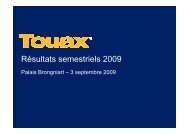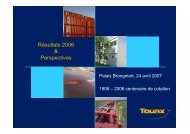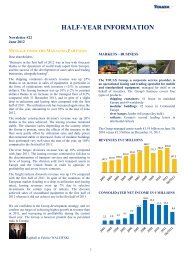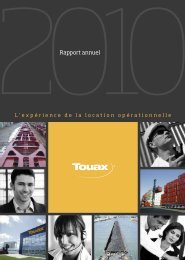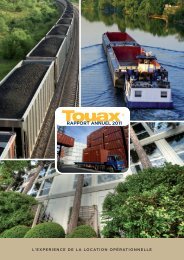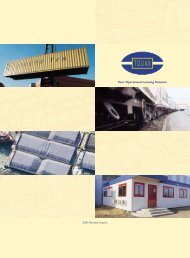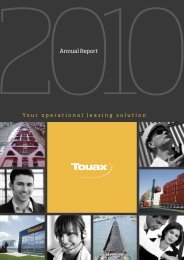2005 Annual Report - Touax
2005 Annual Report - Touax
2005 Annual Report - Touax
Create successful ePaper yourself
Turn your PDF publications into a flip-book with our unique Google optimized e-Paper software.
Financial information concerning the assets,<br />
financial position and results of the issuer<br />
annual report <strong>2005</strong><br />
it relates to a transaction or event which is accounted<br />
for directly in shareholders’ equity.<br />
The deferred tax is presented under specific balance<br />
sheet headings forming part of non-current assets<br />
and non-current liabilities.<br />
note 1.19. Revenue and expenses of activities<br />
note 1.19.1. Revenue from activities: the various<br />
components<br />
The Group is an operating lessor of standardized,<br />
mobile equipment which it owns or manages on<br />
behalf of third parties.<br />
In the case of management for third parties, the<br />
Group purchases new equipment and sells it to<br />
investors. The investors entrust the management of<br />
their equipment to the Group under management<br />
contracts. The Group leases the managed equipment<br />
to its customers (cf. notes to the consolidated<br />
financial statements note 1.19.2 page 60 and note<br />
1.19.3 page 61).<br />
The Group also has trading activities (purchasing of<br />
assets with a view to resale – cf. notes to the consolidated<br />
financial statements note 1.19.4 page 61).<br />
Finally, it may resell to investors or to third-party<br />
customers equipment which it previously owned<br />
(capitalized equipment) and leased to customers (cf.<br />
notes to the consolidated financial statements note<br />
1.19.5 page 61).<br />
note 1.19.2. Statement and recognition of revenue<br />
and expenses associated with trust contracts and<br />
management contracts for third parties entered<br />
into by the Group<br />
The Group operates and manages equipment on<br />
behalf of third parties as part of its activities in river<br />
transport and barge leasing and in the leasing of<br />
shipping containers, modular buildings and railcars.<br />
Pools (including the Trusts and the GIE described in<br />
the notes to the consolidated financial statements<br />
note 1.6 page 53) are created for this purpose, bringing<br />
together several investors, including the Group.<br />
This organization allows the pooling of revenues and<br />
expenses for the equipment grouped in a single pool.<br />
From the substantive analysis of the management<br />
and securitization contracts in the light of international<br />
standards, it can be concluded that the Group<br />
is acting in a capacity of principal in its relationships<br />
on the one hand with investors (pools, trusts or GIE)<br />
and on the other hand with customers. The Group is<br />
entirely free to choose the customers, producers<br />
and suppliers with which it deals and in the negotiation<br />
of purchase, leasing and sale prices of the<br />
managed equipment.<br />
Consequently, the Group records in its income statement<br />
all of the income and expense flows generated<br />
by the contracts. The Group records in revenues the<br />
gross leasing revenues invoiced to its customers for<br />
all the equipment managed in pools. The operating<br />
expenses relating to all the managed equipment are<br />
stated in operating expenses. A share of net revenues<br />
is paid to investors (cf. notes to the consolidated<br />
financial statements note 1.19.7 page 61).<br />
The following factors and criteria are taken into<br />
account in determining whether the Group has the<br />
capacity of a principal:<br />
• IAS 18 does not specify the conditions or criteria on<br />
which to distinguish between an agent and principal.<br />
Consequently, having regard to IAS 8, the transaction<br />
may be examined by reference to US GAAP (EITF<br />
99-19), the principles of which do not conflict with<br />
the framework of the IASB or other IAS/IFRS standards.<br />
• The review of the criteria of EITF 99-19 is detailed<br />
in the following paragraphs.<br />
The criteria qualifying a company as a principal are:<br />
• The company is the primary obligor in the arrangement:<br />
TOUAX SCA and its subsidiaries sign Leasing<br />
contracts directly with their customers. The customers<br />
do not know the owners of the equipment.<br />
• The company has general inventory risk: TOUAX SCA<br />
and its subsidiaries are the first to bear the risks associated<br />
with the equipment. TOUAX then turns to the<br />
owners to obtain compensation.<br />
• The company has latitude in establishing price:<br />
TOUAX SCA and its subsidiaries have full freedom to<br />
choose their customers and their leasing rates,<br />
without referring to the owners of the equipment.<br />
• The company changes the product or performs part<br />
of the service: TOUAX SCA and its subsidiaries sign<br />
identical contracts with the customers without any<br />
distinction between the owners of the equipment.<br />
• The company has discretion in supplier selection:<br />
TOUAX SCA and its subsidiaries are free to select<br />
their suppliers without referring to the owners of the<br />
equipment.<br />
• The company has physical loss inventory risk: TOUAX<br />
SCA and its subsidiaries are the first to bear the risk<br />
of loss of containers. TOUAX SCA then turns to its<br />
customers or suppliers to obtain compensation for<br />
the loss of containers and pays this compensation to<br />
the owners of the equipment.<br />
• The company has credit risk: each owner of equipment<br />
bears his own credit risk. TOUAX SCA and its<br />
subsidiaries bear the credit risk for their share of the<br />
pools. TOUAX SCA and its subsidiaries are responsible<br />
for recovery. In the event of default by its customer,<br />
TOUAX SCA is required to do its utmost to find<br />
the owners’ containers.<br />
The criteria qualifying an agent company are:<br />
•The supplier (not the company) is the primary obligor<br />
in the arrangement: As previously stated, TOUAX SCA<br />
60<br />
Consolidated accounts



